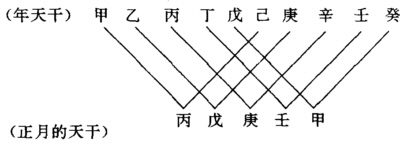Chapter 34 Section 2 Application of Ganzhi in Calendar
We have noticed that since Emperor Wudi of the Han Dynasty, every emperor had to specify his own year name when he came to the throne, and the year when the year name was promulgated was the first year, and the order was lower.Often an emperor will have several reign titles during his reign. For example, Emperor Wu of the Han Dynasty Liu Che had 11 reign titles. The year name was changed to the first year of Taichu.This chronology is discontinuous and obviously inconvenient for long intervals of time that need to be known.Another set of chronology is generally used in history books, that is, the chronology of stems and branches.
Ganzhi is the general term for heavenly stems and earthly branches.The heavenly stems are: A, B, C, D, E, He, Geng, Xin, Ren, and Gui.The Earthly Branches are: Zi, Chou, Yin, Mao, Chen, Si, Wu, Wei, Shen, You, Xu, and Hai.One celestial stem is paired with one earthly branch. The celestial stem is in the front and the earthly branch is in the back. There are 60 pairs in total, starting with Jiazi and ending with Guihai. They can be recorded for 60 years without repetition, and then cycle from the beginning after 60 years.
The method of recording the date of the stem and branch is the same as that of the year of the stem and branch. Every day is represented by a pair of stems and branches, a cycle of 60 days, and the cycle can be endless.From Jisi Day in February of the third year of Lu Yingong in the Spring and Autumn Period (720 BC) to the third year of Xuantong in the Qing Dynasty (1911 AD), the Ganzhi Jiri has been used continuously for more than 2,600 years.Through the conversion of this continuous record and the current Gregorian calendar, almost all events during this period can be identified in time.
The 60 stems and branches are also used to record the month, but they are different from the year and day.First of all, the Earthly Branches are fixed in the order of the month, the first month is Yin, the second month is Mao, ... and the December is Chou.Secondly, when distributing the heavenly stems, the current year's heavenly stems should be considered.For example, when the heavenly stem is Jia or Ji, the heavenly stem of the first month is Bing, the second month is Ding, and the third month is E,... The following is a schematic diagram of the relationship between the annual heavenly stem and the monthly heavenly stem:

Although it has been popular to use orderly numbers to record the month and date since the Western Han Dynasty, historians of all dynasties still mainly use 60 stems and branches to record events. Therefore, if you want to read ancient Chinese books, you must know the usage of stems and branches.

